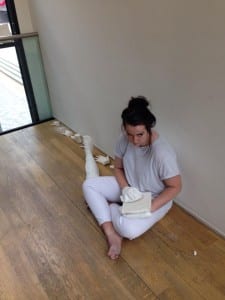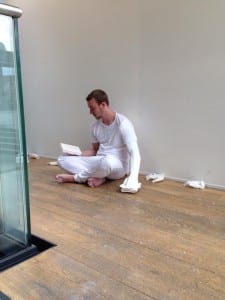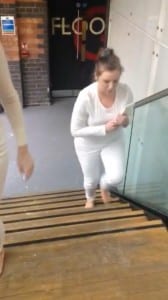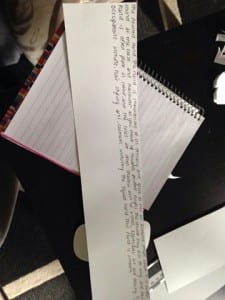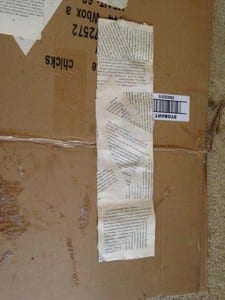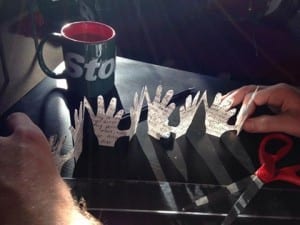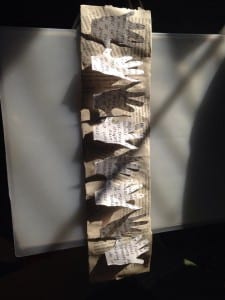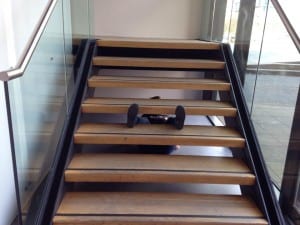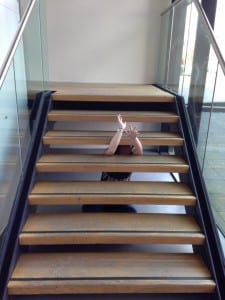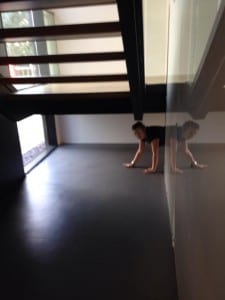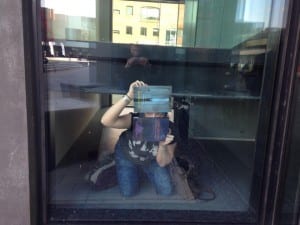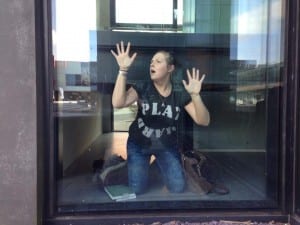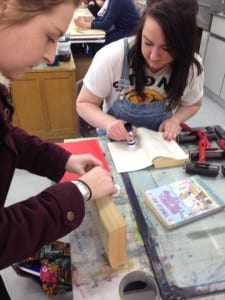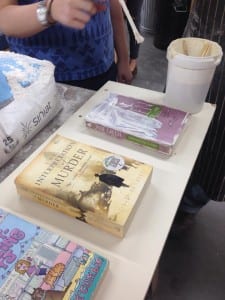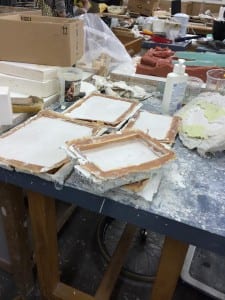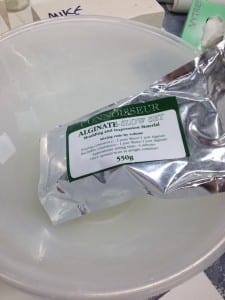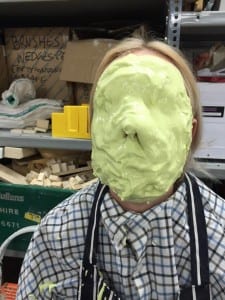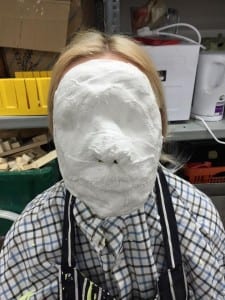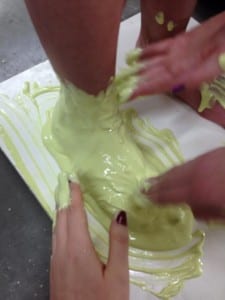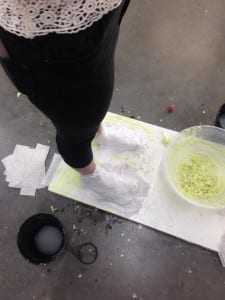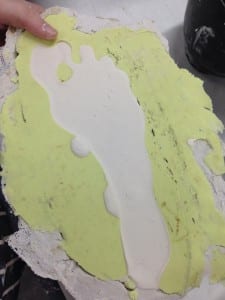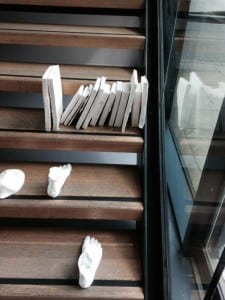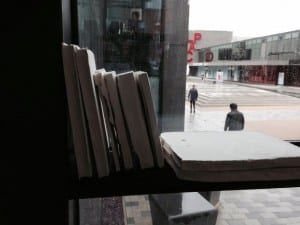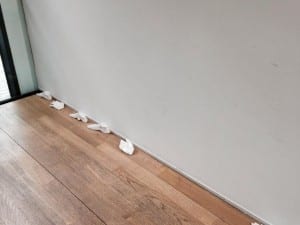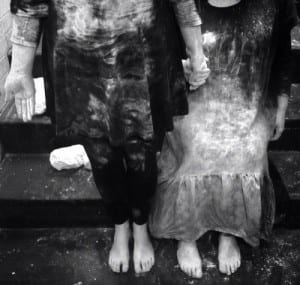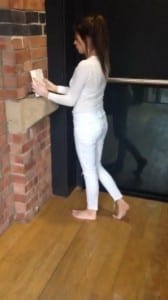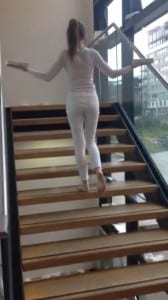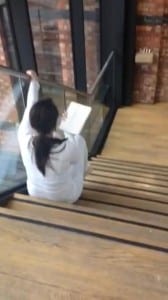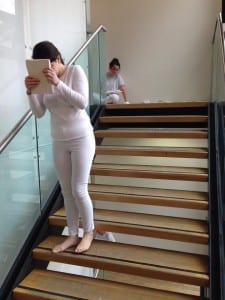Framing Statement
“For Copeau, architecture is the most fundamental and consistently overlooked aspect of the theatre.” (Rufford, 2015, 2).
Until our first Site-specific lesson, I would have never linked buildings with theatre, except from the idea of space and where you are performing. This session and reading has inspired me to look at buildings as performers themselves.
The performativity of a building is what first inspired our creativity. This concept and notion of a performing place has inspired me to think of all other buildings and what they mean or what they could be performing to the people who enter it. Therefore, I couldn’t agree more than with the statement above as it has made me see the University Library with open eyes and an equally open mind.
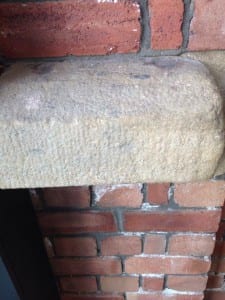
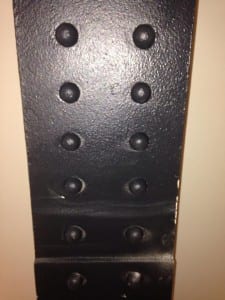
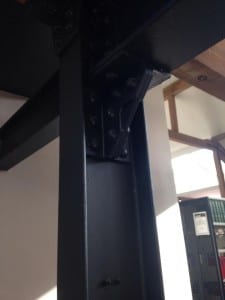
Therefore, the site is a continuous process, and is going through a slow performance. This relates to our work, as our performances required changes and evolved over the day.
The link between the human body and architecture of this building is crucial, yet undermined. The working space has changed and adapted to suit the purpose of the building and the people who wish to use it. It’s also interesting to make the connection between how the building makes the body physically move, for example, how people walk up the stairs or how they sit at a computer desk. These two elements integrate massively; perhaps through art we can express and even challenge this.
Our final performance Set in Stone took place in the front stairwell of the Library, a place people often overlook when travelling to their destination. The performance was an experiment to see the relationship between the physicality of the human body, the architecture of the library and body casts.
Materials such as body casts and plaster books were strategically placed around performers either sat on each floor or performers exploring the use of the steps.
Three performers were sat with the material, whilst the other three explored walking up and down the stairs.
We performed three times throughout the day, and all switched positions each time, offering something different for audiences, which all followed the idea of experimenting with space and time.
We were directly influenced by physical movement artists, sound art installations and sculpture artists. These three components combined is what led to our final performance piece.
Analysis of Process
At the very beginning of the process, we were asked to think about the library and what we noticed about it. With us all being the students, the reason we come to the library is to read and do research for our work. We were then asked to write fifty book titles and create something from one of them.
Inspired by my original book title “How to Read Palms”, I gathered information on the basic art of reading palms and predicting someone’s personality or likely destiny.
It intrigued me to think about how reading can lead to our own interpretations and how this relates to performance with an audience. I wrote the full text onto the card, before cutting away the information to create the shape of hands, this pushes the idea that you can never grasp the full knowledge the text gives.
The creation of this book, even though it is vastly different from the final performance piece, started the creative flow of Site-Specific.
This exercise allowed me to begin to see how materials can be manipulated, and also started the process of creating physical objects. This is something I had never done before, however it became a large factor in our piece in creating body casts from real human parts.
My group and I, after much research and discussion, have all realised the most interesting thing about the library is the people within it. Having a close relationship to the site ourselves, we understand that many other people who use it may feel a similar connection. After spending many hours studying, reading and just being in the library, alone or with others, we feel the library has become a part of us.
Therefore, does that make us be a part of it?
Are we changing the building with our presence?
Do people and buildings share something?
Without bringing people into the building, it would become and empty space. Lea Vergine (2000) discusses this in her edited book Body Art and Performance “The individual is placed at the center of a continuous process that is carried ahead with persistence’s and repetitions” (Vergine, 2000, 8).
This correlates with the repetition that flows through our site. When we look back to it being a factory, workers will have produced work through repetitious manual labour expected of them every day.
This still exists today with library users, whether they use the space for work or social reasons, there are several behaviours that are expected. We can also relate this quote to the actual architecture of the building itself. Over the years, the building has remained, adapted and advanced for the changing purposes of the site. However, there are still features around the library which represents its history, allowing us to see and feel the process the building has experienced.
The human body does share some similarities with buildings, for example, they are both physical and definitely real. However, do buildings highlight more emotional, metaphoric and spiritual elements that may not necessarily be obvious? Does a building offer something much deeper than just structure?
This led to the idea of embedding ourselves into the architecture of the building, becoming a part of it. With the possible use of sculpture, my group and I are currently experimenting of mixing body and architecture and creating links between the two.
Do buildings move?
Does the body and architecture share the same beauty?
Do people and buildings share similar qualities in terms of representation and what lies underneath?
Exploration of Movement
In some spare time, I decided to look at the stairwell alone. It is a fascinating site and I wanted to explore the questions and implications it suggests through its architectural features.
The part underneath the stairs, which everyone overlooks, was incredibly interesting. It appears that nobody notices that area of the building and it seems to have no valid use.
This enclosed space encourages the feeling of being trapped, a feeling I consider to be a reflection of those studying at university. We are trapped within our course and can sometimes feel restricted financially, socially and especially with time.
In the image below, I am representing physically being confined, with the metaphor of students being constricted in their course.
After staying in those position two for about five minutes each, passers by began to notice and looked very confused as to what I was doing. This led to an expectation of what to expect in our final performance.
After reporting back to my group about my own exploration of the stairwell, we decided to spend a couple of days doing this together. What is interesting about the body is that we can do so much with it. However, after observation most library users walk in what we consider “normal”.
We decided to use the stairs in as many obscure ways we could think of.
Although this was a very fun experiment, it actually inspired us for our final performance piece. As our main topic is body and architecture, we found this a very playful way to represent our focus area.
We found more than forty ways to use the stairs in just one session.
A large influence for our movements was Kira O’Reilly,
her use of simple everyday movement placed into a piece of art is mesmerising. Her blog was very inspiring as her contemporary art work is all about physicality of the human body.
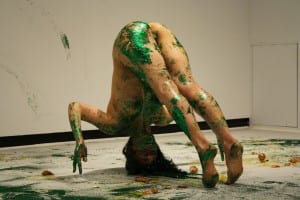
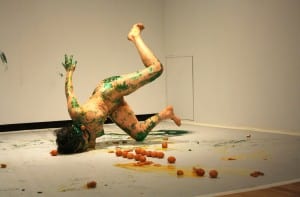
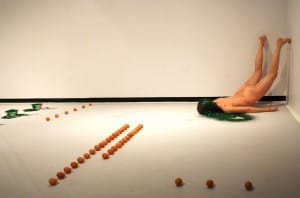 (See Fig 1.)
(See Fig 1.)
One of her most interesting pieces of work was:
Stair Falling (2009)
This piece involves her falling down a staircase in incredibly slow motion. This takes incredible skill and control as a performer, which was inspiring to watch.
Below is a link to the video of the performance:
https://vimeo.com/15900495
This directly influenced our performance and its rehearsal process as we then realised we had to become very intimate with our Site. In order to perform on stairs comfortably, you must ensure you know how to work with the particular setting. Her style of performing also influenced me especially, watching her controlled and elegant performing I decided to convey this in our first performance.
Instead of falling, however, I walked up the staircase and I did not even reach the top floor before our performance finished.
Exploration of Material
One of our influences into working with space and architecture was Rachel Whiteread. Her most popular piece of work House was an inspiration of material and how it can be used to create a theatrical meaning.
Andrew Graham-Dixon describes her work as “one of the most extraordinary public sculptures to have been created by any English artist working this century” (Graham-Dixon, 1993).
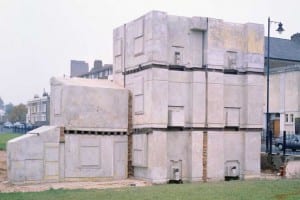
(See Fig 2.)
When seeing these images of her work, we were encouraged to use similar material in our Site-specific performance.
Whiteread’s sculptures are remarkable because they are simple, yet they are
striking.
Her work transforms a site and completely manipulates the meaning, making audiences have a new perspective, which is what we wanted to achieve. The sculpture work in our piece has a great similarity to Whiteread as we used simple body casts and books, yet when placed in Site create a large impact onto the space and performance.
The human body is limitless to work with.
As drama students, we know this to a certain extent. Modroc is an excellent material in creating sculptures, my group and I have been experimenting with it on the body.
Throughout the process, we realised we couldn’t simply create effective body art with just modroc. With help from the art department, we were taught how to make body casts out of plaster.
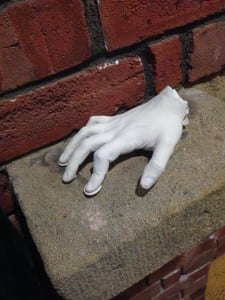
This is a picture is the very first body cast we created.
Before creating more of these, we decided to place the hand around the library in different places.
This task was not just to see how it looked as a piece of art, but to see how the library users responded to it. It was very interesting to observe, some people stopped to look, whereas others just walked straight past. This exercise helped us to see the diversity in our audience, and encouraged us to expand on this project.
Due to the interest we acquired in sculpture we looked at other artists who used body casts, one of them being
Antony Gormley
He is a well known British artist who works closely with sculptures, architecture and the human body, he says in an interview, “I think of my work, certainly in its first phase, as being a kind of architecture.” (Hutchinson et al, 1995, 17).
http://www.antonygormley.com/sculpture/permanent
Above is a link to his website, showing all his sculpture work.
This is very applicable to our performance as we created an installation of sculptures within the stairwell that remained there all day. It is possible to say that we were adding to the architecture of the library building.
“There is a real point of contact with the particularity of my body – slipped from life into art, with every wrinkle of the knuckles embedded in the concrete.” (Hutchinson et al, 1995, 141).
The blend of life and art is crucial to our Site-Specific piece as it is all about how people and architecture combine.
As people have used the building over the decades, they leave traces of themselves, allowing the building to become a very slow and changing piece of art. We physically showed this in Set in Stone with the books, hand, feet and faces that we created.
However, adding the live performance of ourselves and the passers by really represented the relationship between art and real life.
In order to create the materials, we had to learn new skills and became very close with the art department. The technician Robert Britt worked very closely with us and gave us an introduction to using plaster.
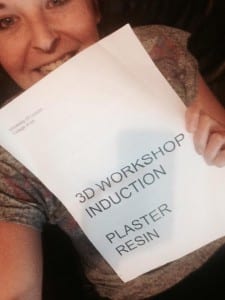
We wanted to be ambitious and make as much material as possible, although our concept was simple (much like Whitereads work) we wanted to create an impact and really change and develop the space.
I, myself, dedicated fifteen full days in the art department making sculptures.
This resulted in 105 hours’ worth of work before even experimenting with the material in Site.
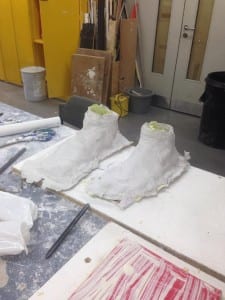
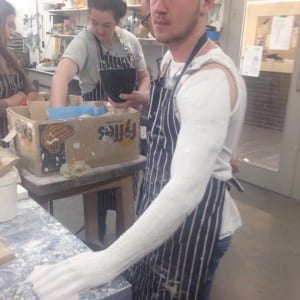
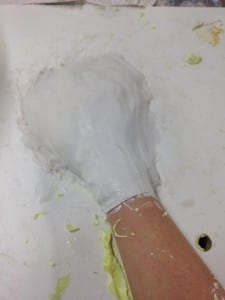
We resulted in making 60 Books, 40 hands, 30 feet and 3 faces.
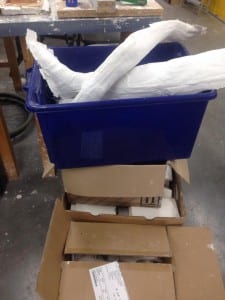
Exploration of Site
Working on Site with all the materials became incredibly interesting. At first we wanted to place feet and books on the actual steps.
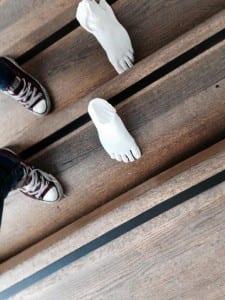
Although after consulting with the library staff, we were not allowed to obstruct any of the stairs because it is one of the emergency exits for the building and our materials caused a safety hazard.
We already expected there to be some complications using the stairs of the library, so we had prepared for this answer already. Instead of using the steps as “book shelves” like we’d planned, we used the window ledges. With the feet we placed them against the wall next to the performers, almost representing an evolving line.
This is where art and the real intertwine.
Michael Pinchbeck’s work on The Drawing Board was an inspiration that came very late into our work.
(See Fig 3.)
We found the work interesting where they throw their creations down the steps and let them crumble into dust. To me, it represented how a building crumbles over time and can even turn into dust. This is exactly the same for the human body, not only do we experience this through our lifetime as we grow older, but when our body decays it turns into nothing.
Below is a link to the video:
http://drawingboardproject.tumblr.com/post/104331185935/the-drawing-board-6-traci-kelly-and-rhiannon
This art piece really inspired us and we incorporated this into our last performance.
We began to roll books and hands down the stairs and allowed them to deconstruct.
Another very late influence was the development of our audio within our performance. During the exploration of our Site, one thing that was apparent was the incredible acoustics the space had to offer. It is interesting that you can stand in the stairwell and hear a sound but have no idea where it is coming from.
In Alan Licht’s book about sound art he states: “It is listening to the sound of nature, and the observance of nature, which is a key feature in sound art.” (Licht, 2007, 74).
Due to our piece being about the body, we decided to record people’s footsteps on the stairs and had this playing throughout our three performances. Below is a sample, we recorded several more and looped them together.
With Licht’s quote in mind, the audience were able to listen and have visuals of people walking. This creates the combination or sound and visual art to create more complexity to the performance. This audio helped to echo the conception that people leave their traces onto the building.How many people have walked that path before?
It again integrates the mixture of the real and the art, when performers and spectators were using the staircase it sometimes became difficult to distinguish between the two.
Reflection
After our long day performing on Site, it was clear to see that we had achieved our main aims throughout the entire process. Our aims being to make the connection between the performativity of people and of buildings. Additionally, the mixture of performance art and real was incredibly interesting to observe and be involved in. We successfully installed an art installation and adding music and live performance created the layers it needed to become and effective piece of work. As a group we explored performance like we had never before and we learnt various new skills and attributes along the way.
The representation of body and architecture worked incredibly well. The mixture of constantly moving performance with absolute stillness gave an enormous contrast, but still invited the audience to see the unbelievable similarity between the two dimensions.
An incredibly satisfying element to the performance was the reaction of our audience members. It was clear some were deliberately making themselves spectators, whereas others had no idea what was happening around them. Keeping the area still open to the public created an exciting and diverse action, audience members became a part of the performance without realising it. This was an effective method as we had an excellent mix of fake body parts, live performance and actual real life embedded into our piece.
It would have been excellent to have had a larger audience; however, I feel this would have affected the concept of having everyday normality within the performance. It worked to have people accidently walking through, rather than a purposeful spectator.
If I could alter our performance in any way, is I would have made it a durational piece, rather than having three separate performances. What as so interesting about performing Set in Stone, is that ideas never stopped flowing. After each performance, the group would collaborate and share more concepts that they had considered while performing. This is also why our piece kept developing and changing each time, for example, we experimented with the plaster books much more in the last performance.
